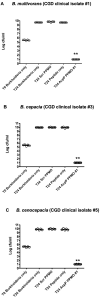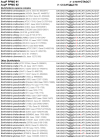Antisense phosphorodiamidate morpholino oligomers targeted to an essential gene inhibit Burkholderia cepacia complex
- PMID: 20438352
- PMCID: PMC2872041
- DOI: 10.1086/652807
Antisense phosphorodiamidate morpholino oligomers targeted to an essential gene inhibit Burkholderia cepacia complex
Abstract
Background: Members of the Burkholderia cepacia complex (Bcc) cause considerable morbidity and mortality in patients with chronic granulomatous disease and cystic fibrosis. Many Bcc strains are antibiotic resistant, which requires the exploration of novel antimicrobial approaches, including antisense technologies such as phosphorodiamidate morpholino oligomers (PMOs).
Methods: Peptide-conjugated PMOs (PPMOs) were developed to target acpP, which encodes an acyl carrier protein (AcpP) that is thought to be essential for growth. Their antimicrobial activities were tested against different strains of Bcc in vitro and in infection models.
Results: PPMOs targeting acpP were bactericidal against clinical isolates of Bcc (>4 log reduction), whereas a PPMO with a scrambled base sequence (scrambled PPMO) had no effect on growth. Human neutrophils were infected with Burkholderia multivorans and treated with AcpP PPMO. AcpP PPMO augmented killing, compared with neutrophils alone and compared with neutrophils alone plus scrambled PPMO. Mice with chronic granulomatous disease that were infected with B. multivorans were treated with AcpP PPMO, scrambled PPMO, or water at 0, 3, and 6 h after infection. Compared with water-treated control mice, the AcpP PPMO-treated mice showed an approximately 80% reduction in the risk of dying by day 30 of the experiment and relatively little pathology.
Conclusion: AcpP PPMO is active against Bcc infections in vitro and in vivo.
Figures





Comment in
-
Beyond antibiotics: new horizons in treating burkholderia species infections.J Infect Dis. 2010 Jun 15;201(12):1786-7. doi: 10.1086/652806. J Infect Dis. 2010. PMID: 20438351 No abstract available.
References
-
- Vanlaere E, Lipuma JJ, Baldwin A, et al. Burkholderia latens sp. nov., Burkholderia diffusa sp. nov., Burkholderia arboris sp. nov., Burkholderia seminalis sp. nov. and Burkholderia metallica sp. nov., novel species within the Burkholderia cepacia complex. Int J Syst Evol Microbiol. 2008;58:1580–90. - PubMed
-
- Guide SV, Stock F, Gill VJ, et al. Reinfection, rather than persistent infection, in patients with chronic granulomatous disease. J Infect Dis. 2003;187:845–53. - PubMed
-
- Lipuma JJ. Update on the Burkholderia cepacia complex. Curr Opin Pulm Med. 2005;11:528–33. - PubMed
Publication types
MeSH terms
Substances
Grants and funding
LinkOut - more resources
Full Text Sources
Other Literature Sources
Medical
Molecular Biology Databases

